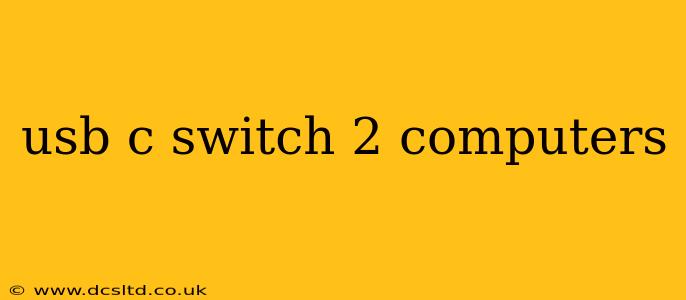The modern workspace often demands juggling multiple devices. For those who frequently switch between two computers, a USB-C switch offers a streamlined solution, eliminating the tedious task of constantly plugging and unplugging peripherals. This comprehensive guide explores the functionality, benefits, and considerations when choosing a USB-C switch for your two computers.
What is a USB-C Switch for Two Computers?
A USB-C switch, specifically designed for two computers, acts as a central hub, allowing you to share a single set of peripherals (keyboard, mouse, monitor, etc.) between them. With a simple press of a button or a switch toggle, you instantly redirect the connection from one computer to another, maintaining productivity without the hassle of manual reconnections. This is especially beneficial for those using laptops with limited ports or for those who want a clean, organized workspace.
What are the Benefits of Using a USB-C Switch?
The advantages of a USB-C switch for two computers are numerous:
- Increased Efficiency: Switching between tasks becomes significantly faster, eliminating the time wasted on repeatedly plugging and unplugging devices.
- Improved Workspace Organization: Reduces cable clutter and creates a more professional and organized workspace.
- Enhanced Productivity: Streamlines workflow by providing seamless transitions between different computers.
- Ergonomic Advantages: Allows you to maintain a comfortable and consistent setup regardless of the computer you're using.
- Protects Ports: Reduces wear and tear on your computer's USB-C ports from repeated plugging and unplugging.
What Features Should I Look for in a USB-C Switch?
Several factors should be considered when purchasing a USB-C switch:
- Number of Ports: Consider the number of USB devices you need to switch between computers. Options range from a single USB-C port to multiple USB-A and USB-C ports plus additional connectivity like HDMI for monitors.
- Data Transfer Speed: Look for switches supporting high-speed data transfer (USB 3.0 or 3.1) to ensure smooth performance with high-bandwidth devices.
- Compatibility: Ensure compatibility with your operating systems and peripherals. Check device specifications to confirm compatibility before purchasing.
- Power Delivery (PD): Some switches offer USB Power Delivery, allowing you to charge your laptop through the switch.
- Switching Mechanism: Determine your preferred switching method – button-based, manual switch, or software-controlled. Consider ease of use and your personal preference.
- Brand Reputation: Opt for reputable brands to ensure quality and reliability. Reading reviews from other users can help assess the product's performance and durability.
How Do I Choose the Right USB-C Switch for My Needs?
The selection of the optimal USB-C switch hinges upon your specific requirements. Consider:
- Number of Devices: How many peripherals do you need to switch?
- Device Requirements: Are your peripherals high-bandwidth (external hard drives, high-resolution monitors)?
- Budget: USB-C switches vary significantly in price based on features and capabilities.
- Switching Method: Do you prefer a simple button press, a manual switch, or software control?
Can I Use a USB-C Switch with Different Operating Systems?
Most USB-C switches are designed to work with various operating systems, including Windows, macOS, and Chrome OS. However, it’s crucial to check the manufacturer's specifications to ensure compatibility before purchasing.
What are the Potential Drawbacks of Using a USB-C Switch?
While USB-C switches offer numerous benefits, potential drawbacks include:
- Cost: High-quality switches with multiple ports and advanced features can be relatively expensive.
- Potential Compatibility Issues: In rare instances, compatibility problems may arise with specific devices or operating systems.
- Troubleshooting: If issues arise, troubleshooting may require familiarity with the switch's operation and specifications.
Choosing a USB-C Switch: A Final Word
Selecting the right USB-C switch involves careful consideration of your individual needs and preferences. By thoroughly evaluating features, compatibility, and budget, you can find a solution that significantly improves your workflow and workspace efficiency. Remember to read reviews and compare models before making your final purchase.
